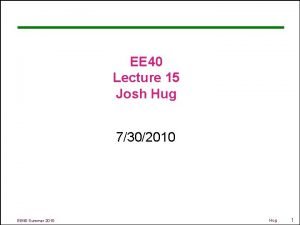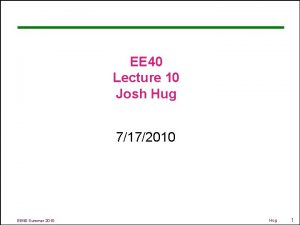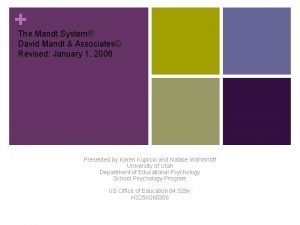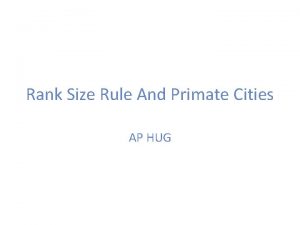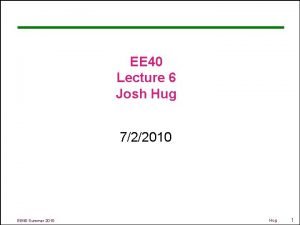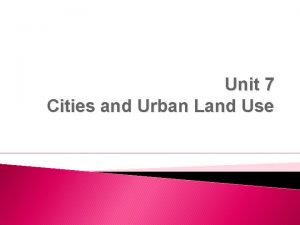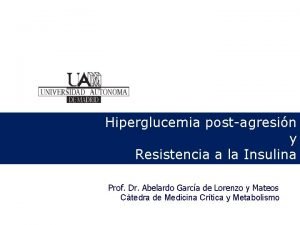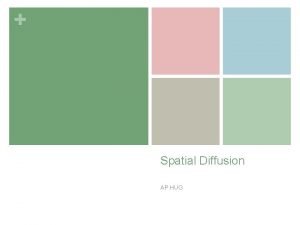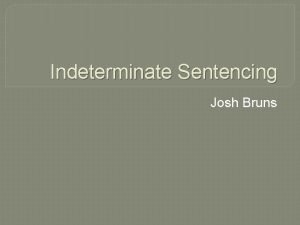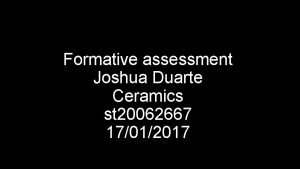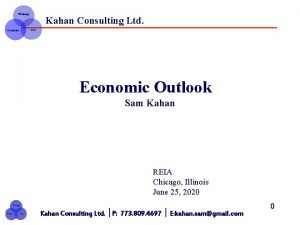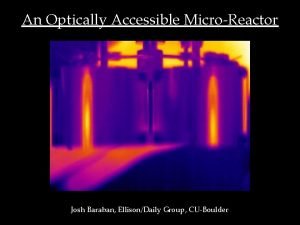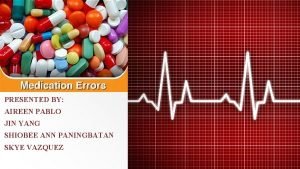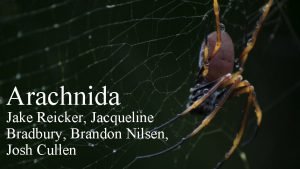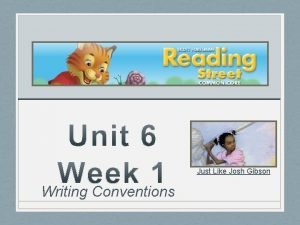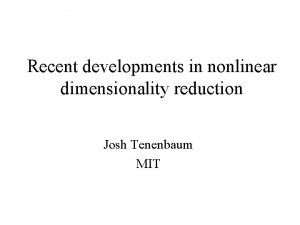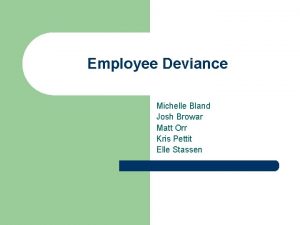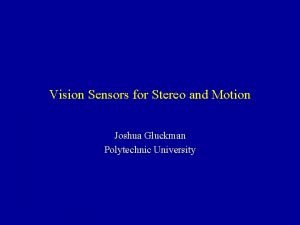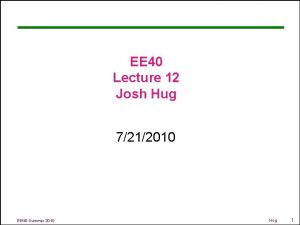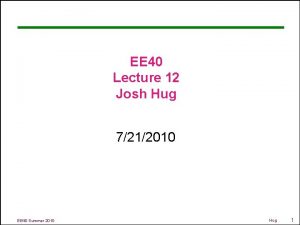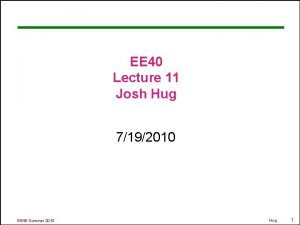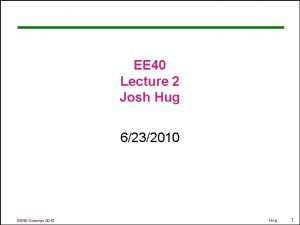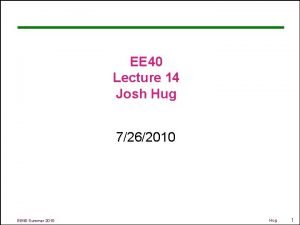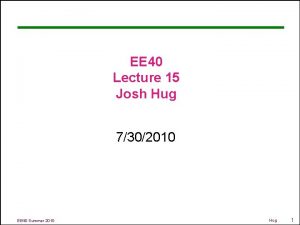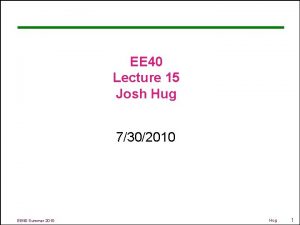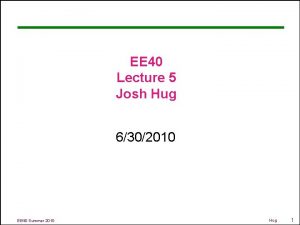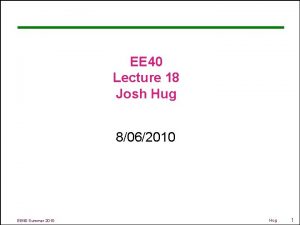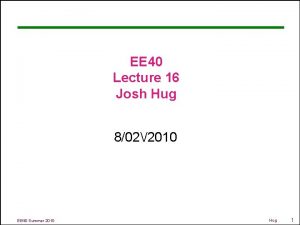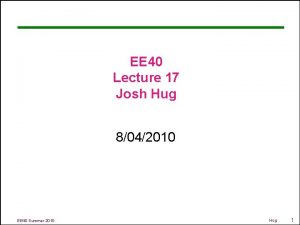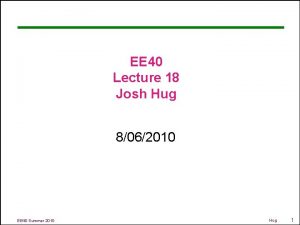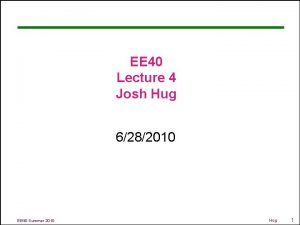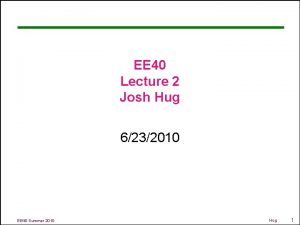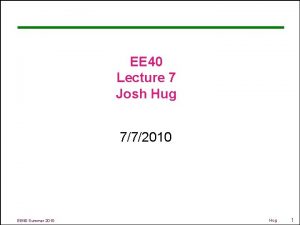EE 40 Lecture 12 Josh Hug 7212010 EE

































- Slides: 33

EE 40 Lecture 12 Josh Hug 7/21/2010 EE 40 Summer 2010 Hug 1

Logistical Things • HW 6 due Friday at 5 PM (also short) • Midterm next Wednesday 7/28 – Focus is heavily on HW 4, 5, 6, and Labs P 1, 4, 5 – Will reuse concepts from HW 1, 2, 3 EE 40 Summer 2010 Hug 2

Filtering • For the past couple of lectures, we’ve discussed using phasors and impedances to solve circuits • Usually, we’ve assumed we have some single frequency source, and found the resulting output • Last time in lecture, we showed that we could apply two different frequencies at one time using superposition – Each was scaled and shifted by different amounts EE 40 Summer 2010 Hug 3

Transfer Functions • EE 40 Summer 2010 Hug 4

Using a Transfer Function • EE 40 Summer 2010 Hug 5

Using a Transfer Function • EE 40 Summer 2010 Hug 6

Transfer Function • EE 40 Summer 2010 Hug 7

Bode Magnitude Plot • EE 40 Summer 2010 Linear Scale Log Scale Hug 8

Bode Magnitude Plot in Context of Circuit EE 40 Summer 2010 Hug 9

Bode Phase Plot • EE 40 Summer 2010 Linear Scale Semilog Scale Hug 10

Bode Phase Plot in Context of Circuit EE 40 Summer 2010 Hug 11

Multiple Frequencies • Real signals are often a combination of a continuum of many frequencies – Radio antenna input – Microphone input • Intuitively: – Thunder contains a bunch of low frequency sounds – Boiling kettles contains a bunch of high frequency sounds • There is a mathematically well defined idea of what it means for a signal to “contain many frequencies” EE 40 Summer 2010 Hug 12

Time vs. Frequency Domain • EE 40 Summer 2010 Hug 13

Multiple Frequencies • The “ 1” button on a phone is a combination of a 697 Hz tone and a 1209 Hz tone EE 40 Summer 2010 Hug 14

Multiple Frequencies • Bill and Ted saying the word “bogus” is a more complex set of frequencies EE 40 Summer 2010 Hug 15

Filtering Example • If we apply a filter with the frequency response on the right to the signal on the left Then we’ll get: EE 40 Summer 2010 Hug 16

More complex filtering EE 40 Summer 2010 Each frequency individually scaled Hug 17

Phase Effects If we shift the phase of the larger sine, we get Original “ 1 button” tone EE 40 Summer 2010 Hug 18

Magnitude and Phase Demo • Let’s try the ever risky live demo EE 40 Summer 2010 Hug 19

Bode Plots • Hopefully I’ve convinced you that magnitude and phase plots are useful • Now, the goal will be to draw them straight from the transfer function • First, some reminders on loglog plots EE 40 Summer 2010 Hug 20

Loglog Plots • EE 40 Summer 2010 Hug 21

Loglog Plots • EE 40 Summer 2010 Hug 22

Loglog Plots • EE 40 Summer 2010 Hug 23

Manual Bode Plots • On board, using handout EE 40 Summer 2010 Hug 24

2 nd Order Filter Example • Also on board EE 40 Summer 2010 Hug 25

2 nd order Bode Plots • Also on board • This is where we stopped in class EE 40 Summer 2010 Hug 26

Active filter example • On board EE 40 Summer 2010 Hug 27

Magnitude Plot Units • EE 40 Summer 2010 Hug 28

Bel and Decibel (d. B) • A bel (symbol B) is a unit of measure of ratios of power levels, i. e. relative power levels. – – – B = log 10(P 1/P 2) where P 1 and P 2 are power levels. The bel is a logarithmic measure Zero bels corresponds to a ratio of 1: 1 One bel corresponds to a ratio of 10: 1 Three bels corresponds to a ratio of 1000: 1 • The bel is too large for everyday use, so the decibel (d. B), equal to 0. 1 B, is more commonly used. – – 1 d. B = 10 log 10(P 1/P 2) 0 d. B corresponds to a ratio of 1: 1 10 d. B corresponds to a ratio of 10: 1 -10 d. B corresponds to a ratio of 1: 10 • d. B are used to measure – Electric power, filter magnitude EE 40 Summer 2010 Hug 29

Logarithmic Measure for Power • To express a power in terms of decibels, one starts by choosing a reference power, Preference, and writing Power P in decibels = 10 log 10(P/Preference) • Exercise: – Express a power of 50 m. W in decibels relative to 1 watt. – P (d. B) =10 log 10 (50 x 10 -3) = - 13 d. B • Use logarithmic scale to express power ratios varying over a large range d. B: EE 40 Summer 2010 Note: d. B is not a unit for a physical quantity since power ratio is unitless. It is just a notation to remind us we are in the log scale. Hug 30

Decibels for measuring transfer function magnitude? • EE 40 Summer 2010 Hug 31

Transfer Function in d. B • EE 40 Summer 2010 Hug 32

Example EE 40 Summer 2010 Hug 33
 Josh hug
Josh hug Josh hug
Josh hug 01:640:244 lecture notes - lecture 15: plat, idah, farad
01:640:244 lecture notes - lecture 15: plat, idah, farad Mandt system
Mandt system Rank-size rule examples
Rank-size rule examples Peel in past tense
Peel in past tense What's wrong in the picture
What's wrong in the picture Remote sensing
Remote sensing Maumee watershed district
Maumee watershed district Gimnazija hug
Gimnazija hug Verb 2 hug
Verb 2 hug Proxy fight
Proxy fight Urban sprawl aphug
Urban sprawl aphug Hiperglucemia
Hiperglucemia Contagious diffusion definition
Contagious diffusion definition Ang simpleng hug pagbati ng hello
Ang simpleng hug pagbati ng hello Josh bostick
Josh bostick Josh bruns
Josh bruns Josh reinert
Josh reinert Josh duarte pottery
Josh duarte pottery Josh farley
Josh farley Josh kahan
Josh kahan Josh baraban
Josh baraban Josh davies work ethic
Josh davies work ethic Josh christianson
Josh christianson Josh barron medication error
Josh barron medication error Jacqueline bradbury
Jacqueline bradbury Just like josh gibson
Just like josh gibson Who does josh lieberman represent
Who does josh lieberman represent Josh tenenbaum
Josh tenenbaum Josh browar
Josh browar Joshua gluckman
Joshua gluckman Josh iche
Josh iche Josh portman
Josh portman
